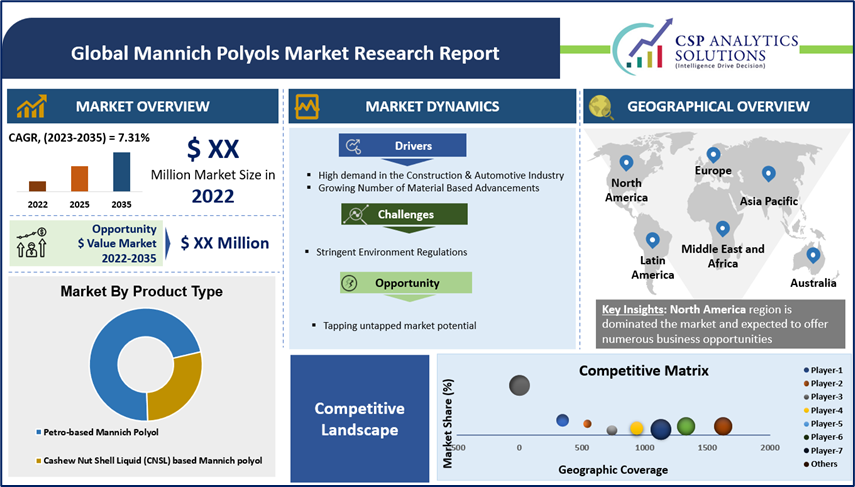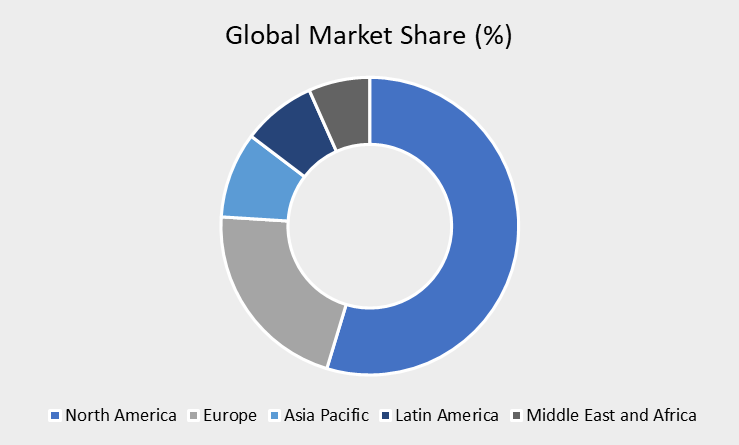Get Free Consultation
The Global Mannich Polyols market is expected to offer an $ opportunity of USD 401.7 million over the analysis period.
Global Mannich Polyols Market size is estimated to cross USD XX Million by the end of 2035, growing at a CAGR of 7.31% during the forecast period, i.e., 2022 – 2035. In the year 2022, the industry size of Mannich Polyols was over USD XX million.
Global Market Size, Forecast, and Trends Over 2022 - 2035
| Base Year | 2022 |
| Forecast Year | 2024-2035 |
| CAGR | 7.31% |
| Base Year Market Size (2022) | Value (USD XX Million), Volume (Tonnes) |
| Forecast Year Market Size (2035) | USD XX Million |
Mannich polyols are a new type of aminic polyethers polyols with aromatic structure, which impart better thermal properties, fire resistance and superior physio-mechanical properties to the resulted rigid polyurethane foams. Polyurethanes (PU) have been extensively used in a broad range of industrial applications, such as foams, textiles, composites, adhesives, sealants, and coatings. For example, the polyurethane demand worldwide in 2017 was about 17.35 million tons, and it is forecasted to grow close to 24.7 million tons by 2024.
Polyurethane chemistry in In the CASE applications, has become more and more fascinating due to valuable properties of superb durability and toughness, excellent abrasion resistance, adhesion strength on various substrates, as well as desired aesthetic finishes.
There are less number of instances at industrial scale of bio-based polyols with an aromatic backbone, as the majority of bio-based materials currently available are soybean-, palm-, or castor oil-based, which can offer hydrophobicity and good flexibility but lack chemical and thermal performances. The structures and properties of polyols or isocyanates as raw materials can significantly affect the physical, mechanical, and chemical properties of the final polyurethane systems. Therefore, the proper design and modification to the raw materials, especially polyols, is an effective way to enhance the performances of polyurethane systems to meet requirements for various applications.

The North America Mannich Polyols market is expected to hold the larger share with a revenue of USD XX Million by the end of 2035. North America, notably the U.S. is one of the most technologically distinctive countries, with an advanced industrial infrastructure and presence of many players in the region are focusing more on product innovations. Highly advanced manufacturing capability and technological competence allows for the development and adoption of Mannich Polyols solutions more rapidly than in other regions. Many other players in other region such as in Europe Huntsman International LLC is also expanding its footprints across geography

Cashew Nutshell Liquid (CNSL) is a sustainable and non-food-chain biomaterial that is contained in the honeycomb structure of the cashew nutshell. Cardanol is the main ingredients derived from CNSL via decarboxylation and distillation. Cardanol is a penta-decadienyl phenol with a long aliphatic side chain that consists of a mixture of one, two, and three double bonds in a linear chain. Such unique and versatile structure enables this natural oil to become a very important chemical building block for numerous bio-based products including polyols.
Agrol Platinum is a liquid-mannich polyols derived from a highly reactive cashew nutshell liquid, and is suitable for all polyurethane applications. Made from an annually renewable feedstock, it is a USDA Certified Biobased Product. Agrol Platinum contains 80.8% bio-based content (ASTM D6866) and Three functional primary hydroxyl groups containing polyol.
Our in-depth analysis of the Global Mannich Polyols Market includes the following segments:
| Global Mannich Polyols Market | |||
| Base Year: | 2022 | Forecast Period: | 2024-2035 |
| Historical Data: | 2019 to 2022 | Market Size in 2022: | USD XX Million |
| Forecast Period 2024-35 CAGR: | 7.31% | Market Size in 2035: | USD XX Million |
| Segments Covered: | By Product Type |
| |
| By Viscosity |
| ||
| By Application |
| ||
| By Region |
| ||
| Key Market Drivers: |
| ||
| Key Market Restraints: |
| ||
| Key Trends: |
| ||
| Companies Covered in the Report: |
| ||